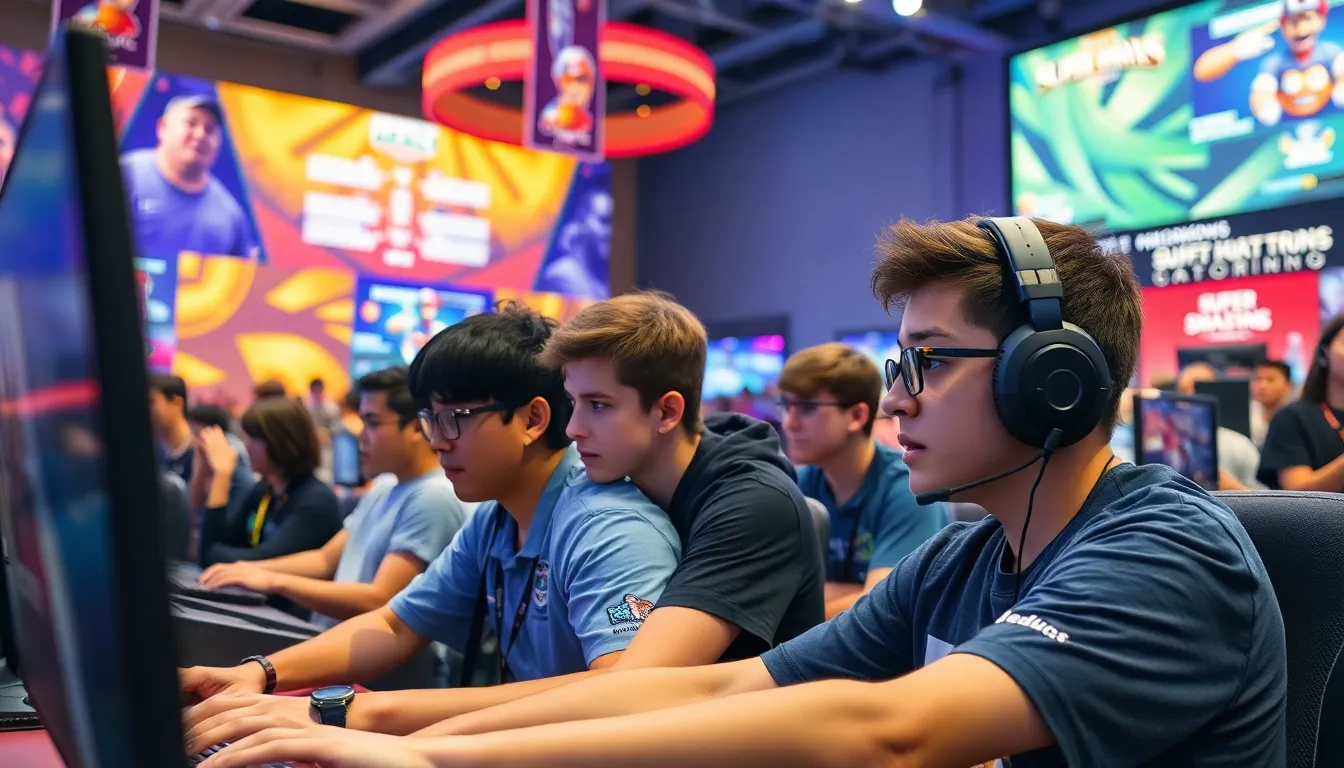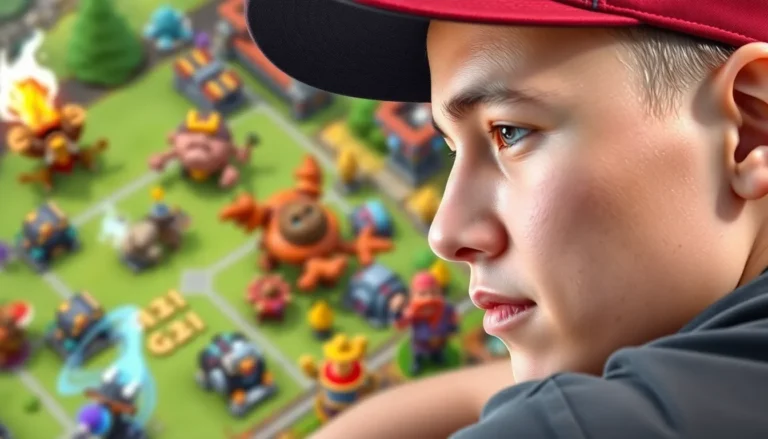In the electrifying world of Super Smash Bros tournaments, chaos reigns supreme, but there’s a method to the madness. Picture this: players hurling their favorite characters into battle, each move calculated yet unpredictable. To keep the fun rolling and the fights fair, a solid set of rules is essential. After all, no one wants to be that player who gets disqualified for using a questionable strategy—unless they enjoy the taste of defeat.
Table of Contents
ToggleOverview of Smash Bros Tournament Rules
Smash Bros tournaments follow established rules to ensure fair competition and an enjoyable experience for participants. Each tournament typically adopts a double elimination format, meaning players have two chances before elimination. Participants compete in matches, with the victor advancing and the defeated player receiving a second opportunity in the lower bracket.
Match rules focus on specific settings and criteria. Stock matches often feature a standard number of lives for characters, usually set at three. Time limits for matches generally stay around eight minutes to maintain a brisk pace. Players can choose from various stages, though some tournaments enforce stage selection rules to ensure consistency.
Character selection imposes limitations that vary by tournament. Most events disallow the use of certain characters, often deemed too powerful or disruptive to balance. Counterpicks enhance strategy, allowing players to select characters in response to their opponent’s choices.
Technical conduct during tournaments is crucial. Players must avoid unsportsmanlike behavior, such as taunting or excessive stalling. Violations can lead to penalties, including disqualification. Observers usually oversee matches to enforce rules and ensure fair play.
Lastly, equipment standards are set for controllers and systems. Participants often need to use specified hardware to ensure compatibility and reduce discrepancies. Tournament organizers typically provide systems and monitors to maintain a consistent playing field.
These rules contribute to an organized and fair environment, allowing for strategic gameplay and dynamic competition. They help maintain the integrity of matches while maximizing enjoyment for both players and spectators.
Tournament Formats

Tournaments commonly utilize different formats to structure matches and determine winners. Each format has distinct characteristics that influence gameplay and player strategy.
Single Elimination
Single elimination tournaments feature a straightforward structure. In this format, players face off in a knockout style, where losing results in immediate elimination. Competitors advance through brackets until a final match determines the champion. This format requires players to perform excellently in each match, increasing pressure. With fewer matches overall, single elimination is efficient for time management, making it suitable for large events with many participants. However, this format lacks the safety net of additional chances, often leading to bitter endings for early round losses.
Double Elimination
Double elimination formats provide an additional layer of fairness. Participants have two opportunities before being eliminated from the tournament. If a player loses a match, they drop into the lower bracket, allowing for a chance to fight back for the title. Key elements in this format include a winners’ bracket and a losers’ bracket, promoting resilient gameplay. Players must adapt their strategies based on opponent skill levels, and the pressure of performing in the lower bracket can be intense. This structure not only balances competition but also enhances excitement throughout the event.
Round Robin
Round robin tournaments emphasize comprehensive play. Every participant competes against all others, providing a thorough assessment of skill and strategy. With multiple matches, a player’s overall performance determines their standing rather than a single knockout round. This format fosters engagement, ensuring spectators witness a variety of matchups. While round robin can be time-consuming, it cultivates an environment where players showcase adaptability against diverse opponents. The ultimate victor emerges based on accumulated wins, adding depth to the competitive landscape.
Game Settings and Standard Rules
Tournament rules establish the foundation for competitive play in Super Smash Bros. Game settings play a crucial role in ensuring fairness and consistency across matches.
Stock and Time Limits
Stock limits typically set at three lives per character create balanced gameplay. Time limits of eight minutes encourage players to focus on strategies for a quick victory. Alternative settings, such as two stocks or five-minute matches, serve specific tournament preferences. Gamers must adapt tactics based on the chosen limits, promoting a diverse range of play styles. Players may experience intense matches with these constraints, emphasizing both skill and speed. Adherence to stock and time limits ensures fair competition throughout the event.
Stage Selection
Stage selection rules dictate which arenas players may choose for their battles. Many tournaments use a combination of neutral, counterpick, and banned stages. Neutral stages provide balanced environments, while counterpicks allow players to select stages that favor their chosen character. Certain stages may face bans due to perceived advantages or glitches, which ensures a level playing field. Players often engage in discussions about stage preferences, adding an extra layer of strategy to the tournament. Adapting to the chosen stage heightens the level of competition, supporting diverse matchups and styles.
Character and Item Restrictions
In Super Smash Bros tournaments, ensuring fair competition involves specific restrictions regarding characters and items. These rules promote strategic gameplay while maintaining balance.
Banned Characters
Certain characters face bans in tournaments due to their overwhelming advantages. Characters like Bayonetta and Meta Knight often lead to debates over balance, prompting their removal from competitive play. Others, such as Little Mac, might be restricted based on specific tournament regulations. An organized list of banned characters exists that varies between tournaments, reflecting community standards and maintaining a level playing field. Players must consult these lists before competing to avoid using restricted characters.
Item Usage Guidelines
Items play a key role in Super Smash Bros matches, but guidelines dictate their usage in tournament settings. Most tournaments prohibit items entirely or allow specific items to maintain competitive integrity. Common items such as Poké Balls or Assist Trophies may be allowed, provided they don’t disrupt balance. Some organizers implement rules regarding item spawning frequency and availability during matches. Understanding these guidelines ensures that players prepare effectively for their matches while adhering to tournament standards.
Conduct and Sportsmanship Rules
Tournament participants must demonstrate respect towards opponents and officials. Unsportsmanlike conduct, including verbal harassment or abusive behavior, leads to penalties or disqualification. Maintaining a positive atmosphere enhances the experience for everyone involved.
Players should arrive on time to ensure matches proceed as scheduled. Punctuality reflects professionalism and commitment to the tournament. Each player must stay engaged and focused throughout the event.
Communication between players and tournament officials must remain respectful and constructive. Questions about rules and decisions can be asked politely, fostering a collaborative environment. Disputes over match outcomes should be addressed calmly, allowing observers to mediate if necessary.
Cheating and exploiting glitches undermine fair competition. Engaging in dishonest practices results in immediate disqualification. Transparency is essential, as players should report any suspicious activities during matches.
Promoting good sportsmanship extends beyond individual conduct. Spectators also play a role in maintaining a positive environment. Support for players should remain encouraging and respectful, avoiding derogatory comments or disruptive behavior.
Flexibility is crucial in competitive settings. Players must adapt to unforeseen circumstances, whether it’s equipment malfunctions or changes in match formats. Accepting adjustments gracefully contributes to a smoother tournament experience.
Lastly, players are encouraged to learn from outcomes, regardless of wins or losses. Each match provides an opportunity for growth, enabling players to refine their skills. Focusing on improvement cultivates a strong competitive spirit and enriches the overall tournament atmosphere.
Understanding Smash Bros tournament rules is essential for both players and spectators. These guidelines create a structured environment that fosters fair competition and strategic gameplay. By adhering to rules on character selection, match settings, and sportsmanship, participants can ensure a positive experience for everyone involved.
As players prepare for their matches, they should keep these regulations in mind to enhance their performance and contribute to the overall atmosphere of the tournament. With a clear understanding of the rules, players can focus on honing their skills and enjoying the thrilling experience that Smash Bros tournaments offer.



